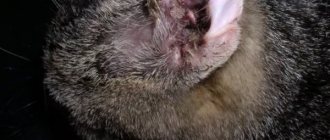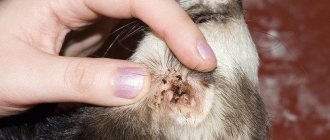If your indoor cat is clearly bothered by his ears, the most likely cause of the discomfort may be otodectosis, which is caused by mites. In this case, the pet requires immediate help. Infection with ear parasites dramatically reduces the quality of life of an animal and can even lead to its death. You will learn how to identify the symptoms of the disease and what medications to successfully treat it from our article.
Structure of a cat's ear
A cat's ears resemble human ears in structure and include:
- external, consisting of a funnel-shaped shell covered with wool with guard hairs inside and the auditory canal;
- in the middle there is an eardrum and a bone cavity with three bones, important in the perception of noise;
- internal - the most complex section, in which the vestibular apparatus and sound receptors are located.
In animals, the auditory canal, unlike the short human one, is curved and forms an angle. Improper cleaning can lead to wax buildup and blockage of the passage.
Cats can hear sound vibrations in the range of 20–100,000 Hz. Muscles and cartilage are able to rotate the shell to pinpoint the source of sound vibrations during hunting.
Drawing - diagram of the structure of a cat's ear
Why do animals scratch their ears?
Scratching your pet's ears is a common hygiene procedure to remove dirt and particles. It is normal to itch several times a day.
What should alert the owner:
- When an animal constantly itches, shakes (shakes) its head vigorously, trying to free itself from an invisible object, and presses its ear with its paw.
- Anxiety, aggressiveness, irritability of the pet.
- Growling, hissing, meowing, and other sounds when scratching.
- Sores, sores, scratches behind the ears (near) and inside.
Such actions can be caused by domestic or pathological reasons.
Household problems are determined by the owner, go away on their own and do not require the intervention of a doctor. These are, in particular:
- water that got in while swimming;
- foreign object;
- minor hematoma from injury;
- scratches the neck - most likely fleas;
- accumulation of earwax due to insufficient care.
There may be cases when the pet lies down. So before you sound the alarm and take your cat to the vet, it’s better to make sure that there really is a problem.
Pathological causes are dangerous to health. The animal needs medical attention if the cause of scratching is:
- abscess;
- allergic reactions;
- fleas;
- fungal infections;
- benign or malignant neoplasms;
- otitis media of various origins;
- ear mites;
- eczema or dermatitis, going bald;
- swollen ear.
Path of infection
Otodectosis often affects cats; dogs, foxes, and ferrets can also suffer; quite rare, but the disease is recorded in rodents (guinea pigs, rats, hamsters) and lagomorphs (rabbits).
Infection mainly occurs through contact with a carrier animal - in crowded conditions, in contact with street animals, kittens can become infected from the mother cat.
Cats that have access to the outdoors are often infected with the disease.
Infection can also occur through contact with bedding and beds infested with eggs or mites, through the owner’s clothing or the pet’s toys. It is extremely rare that ear mites can cause otitis even in humans.
The disease has no seasonality ; an animal can become infected at absolutely any time of the year, but is more often recorded in warm weather (since ticks persist longer in the environment).
Up
What diseases do ticks cause?
Ear scabies, also known as carnivore otodectosis, is a parasitic disease in which a mite lives in or on the pinna of the ear and infects the eardrum or ear canal. The blood-sucking insect causes itching, causing the cat to shake its head and meow. The ear may become scabby and fester. Without intervention, the disease causes complications: otitis, meningitis - or lead to the death of the animal.
Notoedrosis is caused by the sarcopid mite Notoedres cati. The ears, nose, and area under the eyes are affected. The tick affects the nervous, cardiovascular, and reticuloendothelial systems. First, the disease spreads to the muzzle and head, and then moves on to the rest of the body. The animal feels severe itching, scratches its ears, the skin dries out and becomes rough, and bleeding cracks and crusts form.
Otitis is an inflammation of the middle ear. The cat scratches its ears until wounds appear and shakes its head. At the same time, serous fluid with pus is released. This disease is caused by (where does it come from):
- ticks - as a complication of otodecosis;
- bacteria - with a weakened immune system or allergies, the yeast fungus Malassezia develops in the ears;
- both reasons at once - in this case mixed type otitis occurs.
How to determine when it’s time to clean your ears, what happens if you don’t?
Hygiene is one of the main components of caring for a pet. It is better to examine your pet every day: when playing or petting, you can carefully bend the ear and then look. The pet's health is fine if the sink is light pink, clean or with a small amount of sulfur, not dirty (no blackness).
Excess wax accumulates in the ear canal, attracting bacteria and parasites. The sulfur plug leads to irritation of the mucous membrane and begins to put pressure on the eardrum. This spoils hearing and disrupts vestibular functions: leads to impaired coordination of movements, nausea, and vomiting.
Accumulations of dirt can clog the glands, and the contents of the ears can be absorbed into the blood, leading to allergic otitis media. Without treatment, the inflammation spreads deeper and can lead to the death of the animal. With tick-borne otitis media, the parasite eats dead skin cells and causes itching. Scratched areas appear around the cat's ears, and dark spots of pus and sulfur appear inside.
If your pet shakes its head, itches or worries, and black plaque, redness, discharge or spots appear in the ears, this is a reason to contact a veterinarian at the veterinary clinic.
Photo - this is what an ear mite looks like
Symptoms and diagnosis
The owner’s attention is the key to ensuring that any disease is suppressed in the bud in a timely manner. Ear mites are not the most difficult disease to recognize. So it won't be difficult to notice him.
When there is suspicion of otodectosis
You should suspect otodectosis if your furry friend begins to itch frequently. Infection can be determined externally:
- restlessness and shaking of the head, as if a furry friend is trying to throw off some kind of burden;
- dirty brown liquid in the ear canal – it will have a pungent odor;
- the auricle turns red - this is how irritation manifests itself;
- hair may fall out on the outside of the ear and purulent ulcers may appear;
- body temperature periodically rises, accordingly, the animal becomes lethargic - this is the stage of inflammation;
- hearing is partially or completely lost;
- impressive accumulations of sulfur and brown discharge are noticeable;
If the temperature is normal, the pet may meow, run from room to room, and show severe anxiety. In complicated forms, the head begins to tilt towards the affected ear, and the cat itself falls into an apathetic state, loses appetite and moves little. Immediately contact a professional who will help you deal with the situation quickly.
Diagnosis by a veterinarian
Only a qualified veterinarian will determine how to treat ear mites in cats. Before visiting a doctor, the owner can only determine the presence of pests. To do this you will need a cotton swab and a piece of dark fabric:
- use a stick to remove as much of the mass as possible from the ear;
- tap with a stick over a dark surface to shake off pests;
- A bright light is directed onto the area being examined;
- Under a magnifying glass they examine the consistency of the mass: the moving yellowish dots are mites.
Next, you need to urgently go to the doctor. The effectiveness of treatment always depends on how soon the owner seeks professional help. Even if you know traditional methods, you should still ask your doctor how to cure ear mites in cats.
In addition, the veterinary hospital will conduct an examination, a microscopic examination, take a scraping and check the hearing organs. This will not only confirm the diagnosis, but also establish the stage of the disease. According to the neglect, treatment will be prescribed.
When to clean your ears
Cleaning is divided into preventive and therapeutic.
For preventive purposes, cleaning is carried out every 2–4 weeks, depending on the breed, as well as the body of a particular animal. The large ears of Maine Coon, Savannah, Cornish Rex, Abyssinian, Oriental, Somali, Siamese cats, Devon Rex, elves, and Sphynx cats get dirty faster.
Sulfur is especially actively secreted in breeds without hair inside the hearing organ, since the hairs protect against pollution.
It is difficult to clean the ears of the Scottish Fold on your own, so it is recommended to clean them once every two weeks. A small amount of secretion protects your pet from disease, so there is no need to clean it more often.
Therapeutic cleaning of a Scottish or British cat is carried out before treatment against ticks, the use of antibiotics or antifungal drugs. Before each use of drops or rinses, the sink should be cleaned with saline solution or lotion. Parasites and bacteria produce their own byproducts that interfere with the action of medications. Cleaning is prescribed by a veterinarian and is carried out until complete recovery.
Healthy clean ears of a British cat
Folk remedies
Traditional methods of treating otodectosis
A more gentle way to treat a cat is to use traditional folk remedies. They can be used either alone or in combination with medicinal ointment, drops or spray.
- Celandine, or rather its juice, is effective against ticks. To prepare it, use the stems and leaves of the plant, which are passed through a meat grinder. The resulting mixture is squeezed out and used for instillation into the ears (2 drops 2 times a day).
- Garlic. The vegetable, known to everyone for its antiseptic properties, is also used to remove ticks. The raw materials are crushed and filled with almond, olive or sunflower oil. After 24 hours, the mixture is filtered and instilled into both ears, 2 drops once a day.
- Green tea also has equally effective anti-inflammatory properties. A strong brew of it is placed in the ears of an infected animal at least 3 times a day.
- Iodine-glycerin infusion. To treat a cat's ears, you can use a solution prepared from iodine and glycerin, taken in a ratio of 1:4. Treatment with the composition is carried out once a day.
On a note!
You should not replace the use of pharmaceutical remedies with folk remedies if your cat is highly infested with ear mites.
Symptoms of diseases
It is worth paying attention to the health of your pet if:
- redness of the skin;
- increased temperature in certain parts of the body;
- narrowing of the auditory canal;
- tumors;
- change in the color of sulfur;
- unpleasant strong odors;
- squelching sound when pressing;
- excessive sulfur secretion;
- accumulations of pus and fluid;
- various secretions with blood;
- decreased ability to perceive sounds;
- changes in behavior: the cat shakes its head or tilts it to one side, pulls its ear away or runs away when touched, often itches;
- black sulfur, streaks with impurities are a sign of a mite.
Black inclusions in sulfur are often ordinary dirt. If, after cleansing, minor inflammations remain on the skin, you should seek help from a specialist.
Colorless or milky discharge indicates a lack of microelements or vitamins.
Dry ears and waxy scales indicate dermatitis, as well as a lack of fat in the diet.
Allergies are indicated by colorless discharge from the nose, eyes, and ears.
The ears smell like fish if there is a staphylococcus infection, and rotten meat when there is suppuration.
Only a veterinarian can indicate the true cause of ill health and prescribe the correct treatment, so any of these symptoms require consultation.
Photo of bacterial otitis media
Tumor of the seruminous glands
Preparing for cleaning: what to buy
To care for pets, only specialized preparations are used, especially when cleaning the ears. The products protect against fungus and bacteria, prevent infection, and are safe for pets. The instructions for the product should indicate cleaning, not instillation. Under no circumstances should you take anti-inflammatory drugs if there is no indication for it. For cleaning it is recommended to use:
- AUROCLEAN with chamomile extract softens sulfur;
- Leopard, Dewdrop for cleansing ears;
- EAR cleaner cleans;
- Euracon Pharma Otoklin removes dead skin cells, softens sulfur, moisturizes;
- Doctor Vic softens sulfur, used before using medications;
- Veda acts as an antiseptic, heals, removes inflammation;
- Vetoquinol Otifri eliminates impurities, relieves itching, and improves the condition of microflora.
Instead of lotion, you can use saline solution, boiled water, or chamomile decoction.
Prevention of otodectosis
Measures to prevent otodectosis:
- preventive treatment with acaricidal drugs, which are often included in drugs that prevent the appearance of fleas;
- preventing cat contact with stray animals;
- regular monitoring of the condition of the cat’s ears;
- when introducing a new pet, especially one taken from the street, into an established cat community, you need to make sure that it does not have otodectosis;
- regular wet cleaning of the premises where cats are kept;
- steam treatment of beds and soft toys, regular washing of bedding;
- avoiding overcrowding when keeping cats.
If one of the cats living in the house becomes ill with otodectosis, then all pets must be treated, since otodectosis is a highly contagious disease.
What is not allowed during processing is prohibited
The ears of adults and kittens are sensitive and need careful attention. Doctors do not recommend when cleaning:
- use soap, iodine, vinegar, alcohol lotions, hydrogen peroxide. These drugs can cause irritation and dryness;
- use cotton swabs, wrap cotton wool around matches. This can damage the eardrum or push debris into the ear canal instead of out.
Lumps or discharge in the ears are a signal to consult with veterinarians at veterinary clinics.
Cleaning the ears of adult cats
Before the procedure, your pet should be calmed down. Screenings will not cause concern if done from a young age. To prevent the animal from harming itself and its owner when cleaning, the cat can be restrained by wrapping it in a soft towel, leaving its head outside.
Cleaning (washing) the ears of animals is not painful, but it is unpleasant. Wiping the inside of the ears of cats and dogs is not enough. Contaminants should be removed from the ear canal without damaging the organ. How to clean it properly:
- Place your pet on your lap or other comfortable surface.
- Apply the cleansing agent until the canal is filled.
- Press the edge of your ear to the ear canal and massage in a circular motion. The liquid inside should be audible.
- Make the cat shake its head. This will remove contaminants out.
- Wrap your finger in a paper towel (can be replaced with a napkin or gauze), remove any remaining dirt. There is still dirt left, repeat steps 2-4, move to the other ear.
- At the end of the procedure, give your pet a treat.
If there is too much contamination, a home procedure may not be enough. If an unpleasant odor appears, contact a specialist who will use professional cleaning products and also prescribe the necessary treatment, if necessary.
How to treat ear mites in cats: effective drugs
There are many effective drugs for treating ear mites in cats, including both store-bought medications and folk remedies.
Injections
A radical method of eliminating the problem, which only a veterinarian has the right to prescribe. Injectable preparations are highly toxic. They can cause side effects such as allergies, itching, and hair loss. The advantage of this procedure is the extermination of all types of parasites on the pet’s skin. For example, Doramectin (Dectomax, Doramek), Otodectin are used.
Ointments
Ointments based on acaricides help cope with the disease.
The following have proven themselves to be good:
- Amidel-gel. Not suitable for treating the inflamed area in animals at the recovery stage, kittens under 2 months of age. The composition includes: acaricide, analgesic, antimicrobial component, wound healing substances.
- Aversectin ointment. It is not recommended to treat the ears of animals with individual intolerance to the active ingredient - Aversectin, kittens, pregnant and lactating, and convalescent “patients”. Requires additional use of Perhydrol or specialized lotions to remove “crusts” from the ear.
- Ivermec-gel. Contraindicated for breeds sensitive to the active substance, as well as convalescent and depleted representatives of the cat family. Contains an analgesic - lidocaine hydrochloride. Additionally, it has a wound-healing effect.
To achieve the result, you need to clean the animal’s ears, apply the drug to the affected area, fold the auricle in half and do a light massage.
Caution: when using internal medications (drops), you must strictly follow the dosage indicated in the instructions. Otherwise, the poisons, having accumulated, will poison not only the parasites, but also the animal itself.
Drops
One of the most effective and simple methods of dealing with ticks is the use of drops. Their range is distinguished by a fairly wide range of drugs, which allows you to choose the most suitable one for both the kitten and the “mother” during lactation.
The rating of highly effective ear drops includes:
- Surolan. Not recommended for use when the drum membrane is perforated. Contains antimicrobial and antimycotic complexes. Has an anti-inflammatory effect. The frequency of instillation is once every 2 weeks.
- Aurikan. The main substance is the insecto-acaricide Diazinon, which also contains an antiseptic and analgesic. The drug additionally helps to minimize the inflammatory process. For the first week, the auricle is treated daily, then every 3 days.
- Amitrazine. A drug based on a composition of acaricides Amitraz and Dimexide. Repeated treatment is carried out a week after the first procedure.
- Ectodes. Requires preliminary cleaning of the ear canal. This drug is based on propolis and sulfur. Among the contraindications: lactation period, age up to 1 month, violation of the integrity of the tympanic membrane. Frequency of use: every 5-7 days.
- Anandin "+". Consists of Permethrin, Gramicidin and the immunostimulant Anandin. Hearing therapy lasts up to 7 days. If you miss at least one day, treatment starts again.
- Amit. Designed for soaking crusts using a cotton pad twice a day. Course duration is up to 5 days. Contains Prednisolone and Amitraz. If a secondary infection occurs, the product should be replaced. Not recommended for kittens under 2 months, cats during lactation, and mated animals.
- Decta. Contraindications are standard. Frequency of use: once every 3-5 days. Consists of Amitraz, Dexamethasone. Supplemented with propolis.
- Dana. Drops are presented in the form of pipettes. The active ingredient is Diazinon. After the procedure, a light massage is recommended. Requires repetition of actions after a week.
- Mycodemocid. The product contains isopropyl alcohol detergent, sea buckthorn oil, chlorophos. If necessary, the treatment is repeated after 7-8 days.
Sprays
An important advantage of sprays is ease of use. In addition to your pet's fur, you can additionally treat the animal's bedding with the drug. This is done to prevent re-infection.
Among the common products of this type, Ivermec spray is widely in demand. It is recommended to spray it in the ear area a couple of times a day at intervals of 3-5 days.
Advice: you can prevent animals from licking any medicinal composition by wearing an “Elizabethan” collar (veterinary cone) before it dries.
How to clean a kitten's ears
Kittens' ears require inspection and cleaning no less than those of adults. At the same time, the kitten behaves unpredictably and experiences stress.
How to care? The baby must be restrained before the procedure to avoid injury (usually, the kitten is not allowed to have its ears cleaned). An active kitten can be swaddled so that only the head is exposed. Do not tighten your pet's paws to avoid further scaring. After the procedure, give the kitten a treat to compensate for the stress caused. If you clean your kitten regularly, it will get used to it and become calmer. To clean, you will need cotton pads and cleansing lotion or boiled water.
- Gently open the ear with your thumb and forefinger.
- Wet the disc with cleaning fluid.
- Wipe the ear from the inside to the exit.
Where can you get infected?
Let's now look at where a cat can become infected with this mite.
- Option #1. If you bought a kitten, and it complains about its ears, then in this case the infection occurred from its mother, the cat.
- Option #2. If your pet left the house, even for 5 minutes. He went out to the entrance, went to the dacha, exhibition, mating, etc.
- Option #3. You picked up a stray animal and brought it home for a while, even for 5 minutes, and you already have a cat. This is also enough for your pet to receive a portion of ticks.
- Option number 4. There are 2 cats living in the house, one has constant problems with her ears, and the other is fine. This suggests that there is a hidden carrier in your family, i.e. He doesn’t get sick himself, but he constantly infects others. Can you guess who it is? Yes, it is the cat that does not complain about its ears that is the hidden carrier of the tick.











